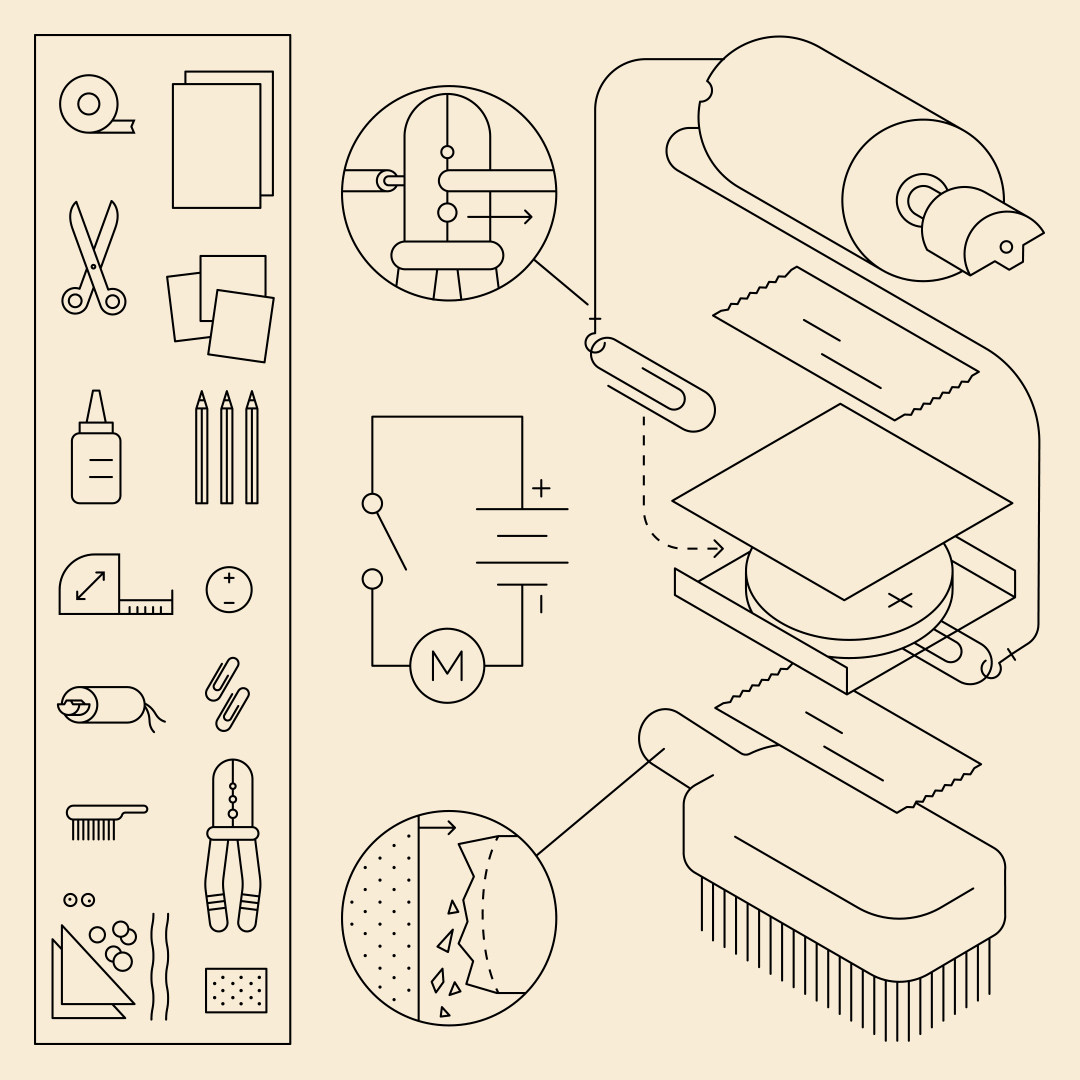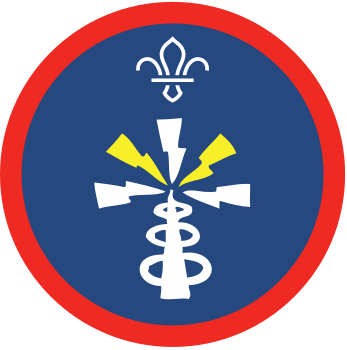
Brush bugs
You’ll need
- Double sided sticky tape
- Scissors
- PVA glue
- A4 card
- Coloured pens or pencils
- Craft materials (for example, tissue paper, pipe cleaners, stickers)
- Scrap card
- Tape measure
- 3V coin battery (with circuit board pins works best)
- Mini vibration motor
- A small brush, like the head from a large toothbrush or small nail brush
- Paperclips
- Wire strippers
- Googly eyes
- Files or sandpaper

Before you begin
- Use the safety checklist to help you plan and risk assess your activity. Additional help to carry out your risk assessment, including examples can be found here. Don’t forget to make sure all young people and adults involved in the activity know how to take part safely.
- Make sure you’ll have enough adult helpers. You may need some parents and carers to help if you’re short on helpers.
Setting up this activity
- Ask people to bring some cardboard from home to use for their bug.
- Check that your motors don’t need more than three volts to work.
- If you’re cutting brush heads from toothbrushes, check that there’s not a sharp edge. You may need to file down any broken edges before you use the brush heads.
- Set out a pile of equipment for each person.
A vibration motor's just a normal motor with a weight on its axle. The weight offsets the axle when it spins, making it unstable. The movement of the weight caused by the spinning of the axle makes the motor move up and down. These sorts of motors are what makes mobile phones and other devices vibrate.
Draw circuit diagrams
- Everyone sit by a pile of equipment.
- Everyone should copy the circuit diagram onto their paper. Their circuit will be powered by a three volt battery, so everyone should label the voltage of the circuit as ‘3V’.
- Everyone should lay the parts of their circuit on their diagram, so it’s clear what goes where.
- Make sure that everyone understands how the circuit will work. When the switch is on, a current will travel from the battery to the motor.
Make a brush bug
- Cut the wires from your motor so they’re about four centimetres long. An adult should supervise everyone as they do this.
- Use the wire strippers to remove one to two centimetres of the insulation (the plastic wire coating) from the end of each wire. Be careful as the wires are delicate. An adult should supervise everyone as they do this.
- Attach a paperclip to each motor wire by looping the wire through the paperclip and folding it back on itself.
- Cut a rectangle of card the same height as the battery and a bit more than three times the battery’s width. Make a battery holder by folding the card into a pocket that the battery can slide into. The battery should be tight in the pocket with two layers of card on one side and one layer of card on the other; it needs to be as snug as a (brush) bug in a rug.
- Use the glue to stick the card together, then remove the battery.
- Use some double-sided foam tape to stick the motor to the top (double-layered side) of the cardboard pocket – make sure that nothing’s stopping the motor from moving.
- Slide the battery back into the pocket.
- Take one of the paperclips and attach it to the single-layered side of the cardboard sleeve. The other end of the paperclip should still be attached to the wire.
- Stick the single-layered side of the cardboard pocket to the flat side of the brush head.
- Attach the second paperclip to the inside layer of the top of cardboard pocket so that it touches the battery terminal. The motor should come to life. Place the bug brush side down and watch how it moves.
- Practise turning the brush bug on and off by removing the paperclip from the top of the cardboard pocket.
- Switch the bug off and attach some decoration to make it look more like a bug. This is a great chance to be creative and make the bug unique. For example, you could add pipe cleaner antennae or googly eyes. People could make functional design modifications too – pipe cleaners can be great stabilisers if a bug keeps falling over.
- Use some cardboard to make a course for the brush bug. Toilet roll tubes, shoeboxes, and tissue boxes all work well.
- Once you’ve finished your course, time how long it takes for the bug to make its way through. Try the bug in someone else’s course. Which bug is fastest? Which course is simplest?
- Test the bugs on some different surfaces. Which surfaces do they prefer? Are any no-go zones?
- Think of some uses for the brush bugs. Could you play a game of hockey with a handful of brush bugs moving a very small ball? What would happen if you attached a small pen and put the bug on paper?
Reflection
Making brush bugs required us to use vibration motors. These have lots of applications in modern tech, from video game controllers to mobile phones. It’s another way for technology to send us an alert.
Which of our senses might detect a vibration? Can you think of other devices that do different things to appeal to different senses? Why might this be useful?
Could you come up with any ways to modify a device, such as a fire alarm, to make it work for someone who is deaf? It could have a wristband that vibrates alongside the alarm side, to alert the user.
Safety
All activities must be safely managed. You must complete a thorough risk assessment and take appropriate steps to reduce risk. Use the safety checklist to help you plan and risk assess your activity. Always get approval for the activity, and have suitable supervision and an InTouch process.
- Scissors
Supervise young people appropriately when they’re using scissors. Store all sharp objects securely, out of the reach of young people.
- Glue and solvents
Always supervise young people appropriately when they’re using glue and solvent products. Make sure there’s plenty of ventilation. Be aware of any medical conditions that could be affected by glue or solvent use and make adjustments as needed.
- Sharp objects
Teach young people how to use sharp objects safely. Supervise them appropriately throughout. Store all sharp objects securely, out of the reach of young people.
- Science
Supervise young people, and only do science activities that are advised and age appropriate for your section. Test activities first, to make sure you’re confident you can lead them safely. Use protective clothing where necessary.
- Manufacturer’s guidelines
All vehicles will be different so always follow the manufacturer’s guidelines.
- PPE
Before completing this activity make sure you have suitable personal protective equipment (PPE). This could include eye or ear protection, gloves, and anything else you need to protect yourself. You’ll know what you need as a result of completing the risk assessment for the activity.
- Electronics
Remove any equipment you’re working on from the power source before you begin. Never assume the power circuit’s off – test it with a voltmeter (and then test it again to be sure). Only connect power to a circuit once you’ve finished working on it and have checked your work. Make sure your circuit isn’t overloaded, and return any covers you’ve removed.
Make sure that all electronics equipment is properly grounded. Use the right electronics tools, and always replace damaged equipment (for example, replace cables rather than repairing them with insulating tape). Always have safety equipment including a fire extinguisher, basic first aid kit, and mobile phone nearby.
If you wish to use larger brushes, you’ll need higher voltage batteries and bigger motors. Then, you can make a whole family of brush bugs!
Make sure everyone has everything they need to complete the tasks in this activity. Have people pair up and have helpers lend a hand when needed.
All Scout activities should be inclusive and accessible.
For an extra challenge, people could make their own vibration motors from a normal motor by attaching a weight to the axle.
You could give it a go with larger brushes. You’ll need higher voltage batteries and bigger motors. Perhaps you could even make a family of different sized brush bugs.
This activity's a great opportunity for those with existing skills or an interest in electronics to share their knowledge.
Encourage young people to pass on their skills to others by helping lead this activity or guiding anyone struggling.
